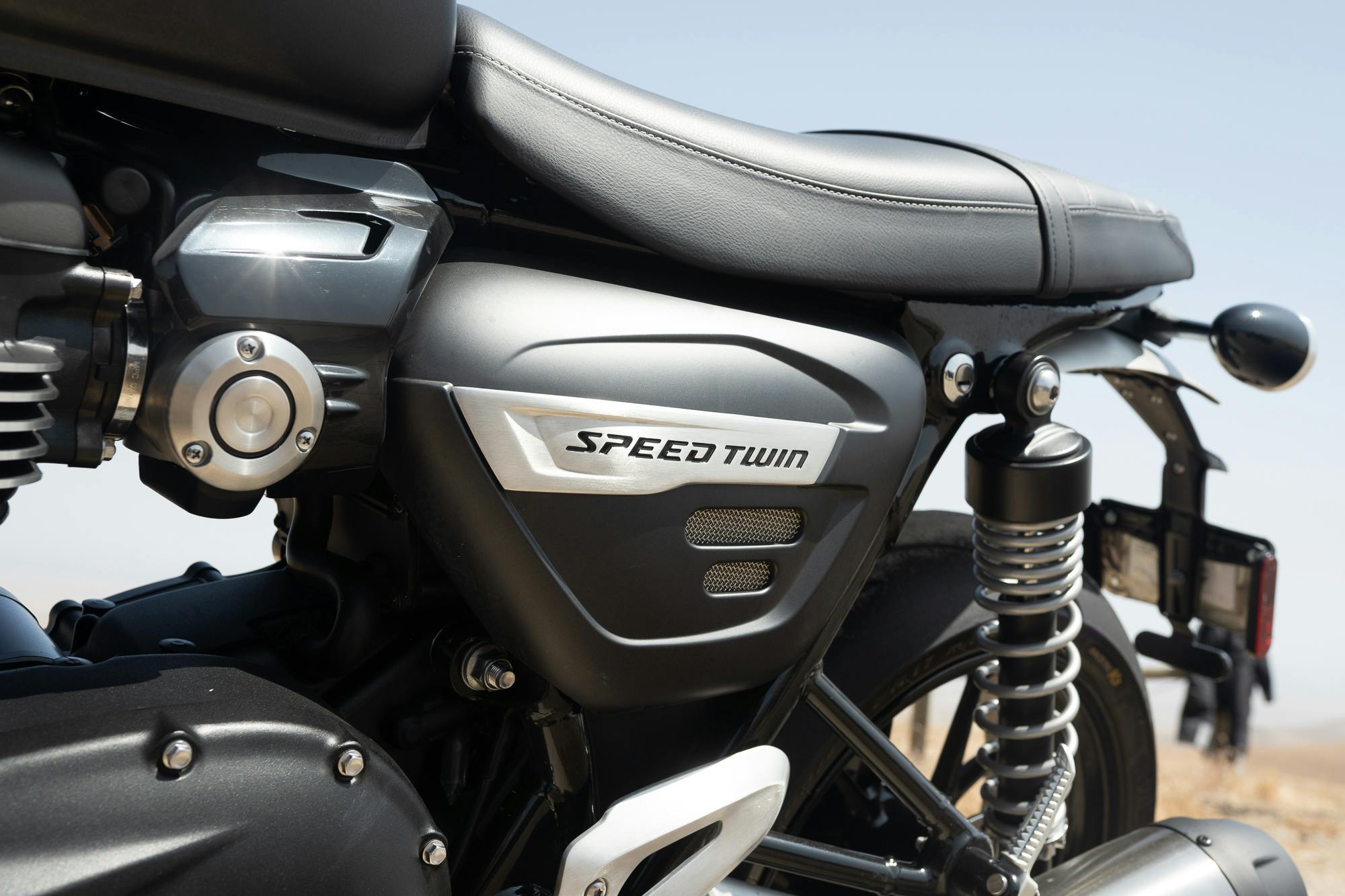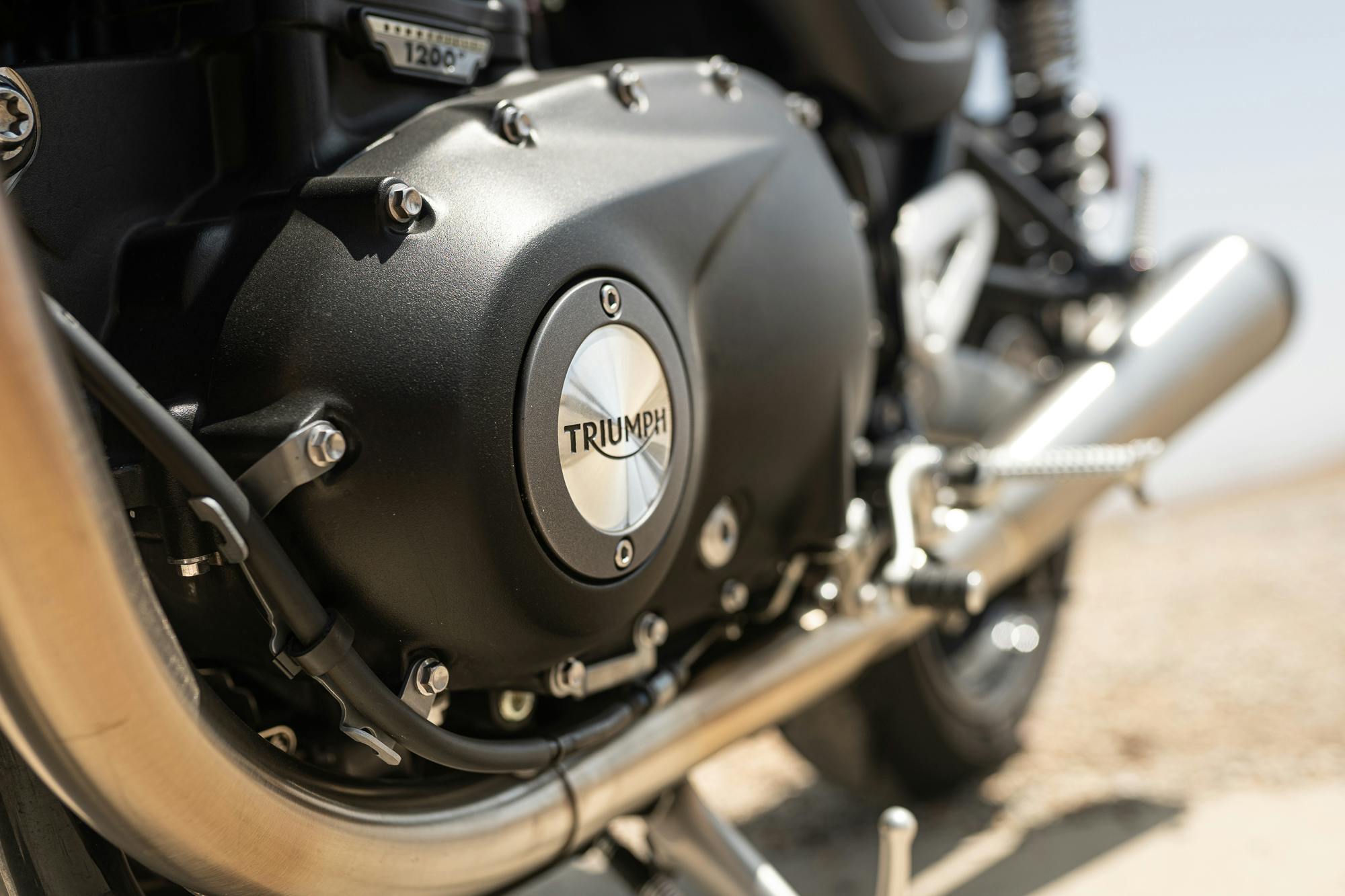Media | Articles
Review: 2022 Triumph Speed Twin
I was clipping along California’s Highway 58 when the peg touched down. A high sun soaked the pavement without interruption from clouds and made my dark-green riding jacket uncomfortably warm no matter how many vents I zipped open. The Triumph Speed Twin underneath kept goading me to ride faster, brake later, lean further, as we snaked through the hills between San Louis Obisbo and McKittrick.
The scrape was quick but still jarring. A footpeg brushing the pavement, the bike leaned over almost as far as it could go.
At just three years old, the Speed Twin is relatively new in the Triumph lineup. At first blush, this seems like a bike no one asked for—strong vintage vibes from that tube-steel frame and those twin shocks, but a spec sheet that not-so-subtly lays out track aspirations. As Triumph tells it, the Speed Twin slots somewhere between the company’s more traditional T120 Bonneville—the Sixties tribute model with skinny forks and vintage looks—and its long and low Thruxton cafe racer, also based on the Bonnie. On paper, that personality can seem a little forced. This isn’t a comfy nostalgia play and it’s not an old-world corner carver, though you have to trace Triumph’s heritage all the way back to 1937 to find the roots of the name. The original Speed Twin came from the mind of Triumph chief designer and managing director Edward Turner, who shaved weight from one of Triumph’s relatively simple steel frames before bolting in a 500-cc parallel twin. Single-cylinder bikes were more common back then, but Turner’s idea wasn’t revolutionary in the late Thirties, and the new Speed Twin isn’t revolutionary now. It’s just old-fashioned hot-rodding within a price and a blueprint, adding quality components and paying attention to the details.
The silhouette here is distinctly Bonneville. The engine case even wears that name, but the Twin shares little with the current version of the retro model that brought the Triumph brand back from the brink in 2001. The brand now uses the “Speed” nameplate on multiple engine-chassis combinations, with the staid, Bonnie-based bikes on one end of the spectrum and the full-fairing, track-ready Daytona models on the other.
This bike feels and looks mature, its blacked-out details grown-up but still playful. The 1200-cc twin beneath that slender tank makes 100 hp and 83 pound-feet of torque, and for 2021, it gained a lighter crankshaft and a revised cam profile, improving response. The pops of grey from the aluminum triple clamps and fenders complement the machined cooling fins on each cylinder barrel. There’s none of the flash of faster and more powerful Triumphs, but this isn’t a machine for beginners. The narrow and low-swept handlebar, the flat seat, and those comfortable rearsets are certainly inviting, but it takes more than a little self control to keep this two-cylinder machine under the speed limit. The whole package seems to reward hooligan behavior, and you can easily get caught riding faster than you planned. Or surprising yourself with a dragged peg.
Marketplace
Buy and sell classics with confidence
This is where those details count. That steel frame might not sound sporty on paper, and at 476 pounds, the Triumph isn’t exactly light. Describe the Speed Twin’s chassis to a bike person who hasn’t ridden it, they’ll likely tell you that they don’t have any interest in wallowing through corners. But the Twin doesn’t wallow. Steel gives the frame a forgiving feel, and the bike goads you into putting more angle into each corner. The twin-shock aluminum rear swingarm is simple, classic, and very pretty. You can overslow for corners and revel in the exhaust note as you rip out on the back tire, or you can smoothly set the whole thing up for a race line and delight in the feedback from that 43-mm Marzocchi front end. Those peg feelers never stood a chance.
Big brakes complement the capable chassis. The Brembo M50 radial monoblocs up front rein in the bike with aplomb. Lever feel is linear and allows for easy trail braking. Those swept bars are pretty, but they’re also a perfect blend of narrow and wide, so you can muscle and lever the bike to your will while still in a fairly upright and comfortable position. (Try that on a Thruxton.) Add in the sticky Metzeler Racetec RR tires, and you have a confidence-inspiring and comfortable package for anyone who can tolerate the Triumph’s lack of windshield or fairing.

Finally, there’s that engine, the Twin in the bike’s name. It feels like a traditional modern Bonneville dialed up just a bit—still all rumble and easy torque, but also a little smoother, a little more snappy, more powerful. It also feels like a cheat code on a video game, smooth and tractable across the entire rev range. If you don’t feel like revving the bike out, clean low-rpm fueling lets you quickly row the shifter to fourth or fifth gear, and then lazily squirt through traffic with ease, riding that wave of torque, no need to rack the gearbox to keep moving.
Three rider modes (Sport, Road, and Rain) and anti-lock brakes round out a small but highly functional rider-aid package. Rain is clearly torque-limiting, but in any mode, you can chop the throttle to load the front end before grabbing a fistful of power, making the front wheel rise in a nice and predictable way. When intentionally working to trip the ABS, the system cycled quickly and was hardly abrupt, though it occasionally came off as slow to intervene—possibly a byproduct of those gummy Metzelers. Range is really the only negative: That gorgeous and traditional fuel tank fits the bike’s aesthetic nicely, but its 3.8-gallon capacity disappears quickly when you’re riding as the Triumph begs to be handled. Over several days of travel and testing across Southern California, we saw roughly 110 miles between fill-up and the point where the Twin’s fuel-reserve light would recommend a stop.
This is a shame, because everything else here makes you want to go places. As with any unfaired motorcycle, one needs to be prepared for the wind blast, but the buffeting is no worse than with any other standard bike. The seat was comfortable in traffic and tolerable for moderately long days on back roads or highway, especially when you’re shuffling body weight around in corners. You just want to keep riding.
The triumph of this motorcycle—no pun intended—is the experience. Five minutes with Google will suggest a dozen bikes more comfortable, more powerful, more affordable. What you’ll struggle to find is a machine that blends so well what so many riders want. Every bike is a compromise, but the Speed Twin strikes a delightful and rewarding balance landed by few: It is a lovely and unassuming package with an appropriate amount of soul. It’s a throaty twin with timeless looks. It’s responsive, comfortable, and quick, and while it may not handle like a modern race replica, it uses modern components where it counts and works well enough that you seek out corners.
From the long flat seat to the fake Bakelite spark-plug boots and the delightful negative space under those faux-carburetor throttles, the Speed Twin is a stupendous blend of contemporary and classic. If the looks draw you in, a ride will seal the deal. The fit and finish is appropriate for the $12,499 MSRP and it absolutely looks and feels like a Triumph.

I fell in love with this bike this summer over just two days of testing on the road. The only reason I haven’t placed an order is opportunity cost, thinking of the various projects and silly adventures that twelve grand could buy instead. But this is a spectacular motorcycle, caught happily between two worlds. At not quite a dedicated sport machine and not quite a standard, the Speed Twin creates its own little niche in the market. If you want a good-looking motorcycle simply so you can enjoy motorcycling, with little compromise and some speed and a lot of heart, this one needs to be on your list.
***
2021 Triumph Bonneville Speed Twin
Base price/as-tested: $12,500 / $12,800
Highs: Comfortable and confidence inspiring chassis, exhaust note that begs for more throttle, good electronics package.
Lows: Range can be a bit of a bummer with a machine this fun to ride.
Summary: A modern muscle roadster that is delightful to ride and look at. Performance and presence in a timeless package.

















